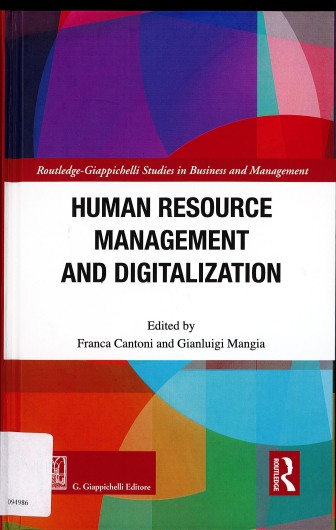| Part III – LEVERAGES | |
| 8. Individual Versus Organizational Learning for Knowledge in Innovation 4.0 Era - Paolino Fierro, Paola Briganti, Luisa Varriale | 153 |
| 8.1. Introduction | 153 |
| 8.2. Individual learning versus organizational learning in the traditional era | 154 |
| 8.3. Organizational learning in the digital era | 164 |
| 8.3.1. Organizational learning for innovation: applications and techniques | 167 |
| 8.4. Organization learning for innovations: managerial implications and final remarks | 172 |
| References | 175 |
| 9. The Digital Transformation of Leariiing. ImplicatlOns for Organizational Training - Roberta Virtuani-Alessandro Bottazzi | 177 |
| Introduction | 177 |
| 9. 1. Trends driving the change of organizations toward a digital transformation | 179 |
| 9.2. The employee learning experience | 181 |
| 9.3. The role ofmanagers and company training | 184 |
| 9.4. The value of different ways of learning for and at work | 185 |
| 9.5. Digital workplace solutions supporting the learning process | 187 |
| 9.6. Case study: How Cisco Services up-skilled 14,400 employees and transformed into a consultative, solutions-selling organization | 189 |
| 9.7. Case study: Digital transformation of training in ENEL. From "Training" to "Open Power Learning" | 194 |
| 9.8. Conclusion | 202 |
| References | 203 |
| 10.Social Media Strategy within Organizational Communication Major Open Issues and Challenges - Francesca Di Virgilio, Mònica Valderrama Santomé,Alba Lçpez Bolàs | 207 |
| 10.1. Introduction | 207 |
| 10.2. Social media definitions and research topics | 209 |
| 10.3. Social media practice and user behaviour | 213 |
| 10.4. Social media strategy within organizational communication | 214 |
| 10.5. Social media security and the impact on the organizational communication: some scientific enquiries | 216 |
| 10.5.1. Various attacks on social media | 218 |
| 10.6. Future research directions | 220 |
| 10.7. Conclusion | 222 |
| References | 223 |
| Part IV - COMPETENCIES AND ROLES | |
| 11. Digital Revolution Equals Digital Competencies? What We For Workers' Competencies in Industry 4.0 - Martina Gianecchini, Caterina Muzzi, Diego Campagnolo | 231 |
| 11.1. Introduction | 231 |
| 11.2. Industry 4.0: jobs, workers and skills | 232 |
| 11.3. Implications for stakeholders | 235 |
| 11.4. Conclusion | 241 |
| References | 241 |
| 12. Digitalization and HR Analytics: a Big Game for an HR Manager, Tommaso Fabbri, Anna Chiara Scapolan | 243 |
| 12.1. Introduction | 243 |
| 12.2. The digitalization of the enterprise: an organizational perspective | 244 |
| 12.3. The digitalization of HRM | 245 |
| 12A. The transformation of HRM in the digital enterprise | 247 |
| 12.4.1. HR as a managerial function: the design of the digital workplace | 247 |
| 12.4.2. HR as a set of practices: data-driven HRM | 248 |
| 12.5. Implications for practice and research | 251 |
| References | 253 |
| 13. Industry 4.0 and the Emerging Challenges to Leadership - Alessio Paris, Luca Giustiniano | 255 |
| 13.1. Human dimensions of industry 4.0 | 256 |
| 13.2. The robotic workforce's deep learning | 257 |
| 13.3. Non replaceable practices human leaders need to foster | 257 |
| 13. 4. Organizational "ambidexterity" | 258 |
| 13.5. Conclusion | 259 |
| Part V – INSTITUTIONS | |
| 14. E-Learning Experiences in European Universities: a Multiple Case Study Analysis - Davide Bizjak, Teresa Anna Rita Gentile, Ernesto De Nito, Paolo Canonico | 263 |
| 14.1. Introduction | 263 |
| 14.2. E-learning tools | 264 |
| 14.3. Methodology | 265 |
| 14.4. Case studies | 267 |
| 14.4.1. Pilot-case: University of Naples Federico II (Italy) | 267 |
| 14.4.2. Case Study 1: University of Dresden (Germany) | 267 |
| 14.4.3. Case Study 2: Queen's University Belfast (United Kingdom) | 268 |
| 14.4.4. Case Study 3: University of Bologna (Italy) | 269 |
| 145. Results and discussion | 269 |
| 14.6. Conclusions | 274 |
| References | 275 |
| 15. Strategic Decision Making Process in RM Practicies: Data Analysis as Innovative Tool to Prevent Corruption -Federico Ceschel-Alessandro Hinna-Alessandro Pastorelli | 277 |
| 15.1. Introduction | 277 |
| 15.2. Theoretical background | 278 |
| 15.3. Research Methodology | 280 |
| 15.4. Case study background | 281 |
| 15.4.1. Regulatory background | 281 |
| 15.4.2. The National Anti-corruption Plan and the standard ISO 31000:2010 | 283 |
| 15.4.3. The state of implementation of anti-corruptlon strategy | 285 |
| 15A.4. The National Institute for insurance against Accident atWork | 286 |
| 15.5. Empirical evidence of the case study | 287 |
| 15.5.1. "ARCO processes" e "ARCO risks" | 288 |
| 15.5.2. "ARCO compliance" | 289 |
| 155.3. "ARCO operational audit" | 290 |
| 15.5A. "ARCO transparency" | 290 |
| 15.6. "ARCO Data Analysis" | 292 |
| 15.6.1. Predictive analytics | 294 |
| 15.7. Conclusion | 295 |
| References | 297 |
| Authors | 301 |


